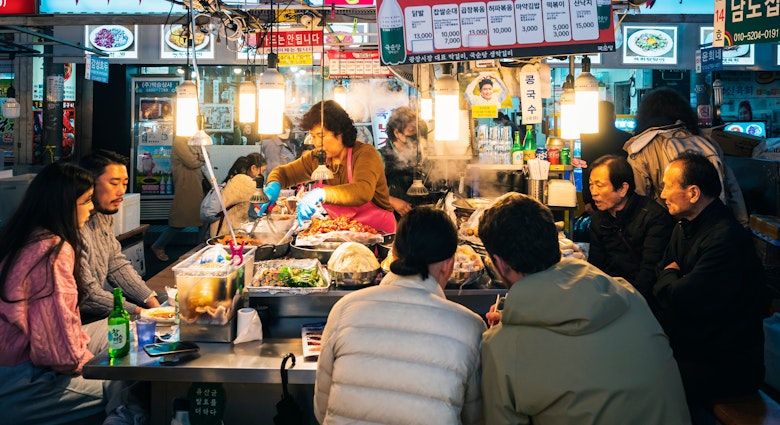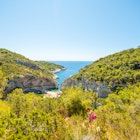
Jun 19, 2024 • 8 min read

South Korea's mostly mountainous terrain offers world-class hiking for every ability level © stockstudioX / Getty Images
Roughly 70% of the Korean peninsula is covered in mountains, so it’s no surprise that hiking is one of the country’s national pastimes.
Koreans take the pursuit seriously, joining hiking clubs and buying pricey gear, but novices have plenty of opportunities to join in, too. Many trails require no more than a decent pair of sneakers and not all treks in South Korea are mountain ascents either. While you’ll find many places where you can scale dramatic alpine peaks, you’ll also find relaxing seaside strolls and engaging urban rambles.
More than just a good workout, hiking in Korea is a way to discover the country’s history – from mountain myths to remote Buddhist temples – and natural blessings, like volcanic tuff cones and blazing fall foliage. Best of all, it’s a chance to commune with Koreans in the place they’re most at home: on the trail.
9.6km (6 miles) one way, 4.5 hours, moderate
As the local saying goes, “Jeju is Hallasan, and Hallasan is Jeju.” Hallasan Mountain lords over Jeju-do from its absolute center, never letting you forget who’s boss on this subtropical island. At 1947m (6388ft), the shield volcano is South Korea’s tallest peak and has traditionally held sacred significance to Koreans.
Unsurprisingly, it’s an enticing target for anyone into collecting summits. The best route up is the Seongpanak Trail on the volcano’s east flank, departing from the Hallasan National Park Visitor Information Center off Highway 1131. The trail begins with a path of black volcanic stones running through a gotjawal, a forest that grows out of the basalt underfoot and that gives these first kilometers a primordial feel. A bit more than 5.6km (3.5 miles) into the trek is a 40-minute spur that leads to Sara Oreum (parasitic volcano cone), which has a small crater lake at the top.
Once you reach Jindallae-pat (Azalea Field) Shelter, things start to get serious. The slope on the last 2.3km (1.4 miles) to the summit increases, and high winds are common (and snow in winter), so make sure you have warm clothing for this leg. Even so, the ascent isn’t technically difficult, and much of it consists of staircases. At the top, you’ll get views of Baengnokdam, a 400m-wide (1,312ft) caldera that at certain times of the year contains a crater lake. Head back down the way you came or take Gwaneumsa Trail down the north slope to come out near Jeju-si City.
To hike both Seongpanak and Gwaneumsa, you must make a reservation in advance.

16km (10 miles) one way, 12 hours, challenging
With mythic landscapes of soaring granite peaks, secluded valleys and majestic waterfalls, Seoraksan National Park is Korea’s most inspiring terrain. The north-to-south Daecheongbong Peak Course carries hikers through the heart of the park and hits many of its highlights, including the eponymous Daecheongbong, the park’s tallest peak at 1708m (5604ft).
The hike starts near the Seoraksan Cable Car in the village of Seorak-dong, where several restaurants and cafes provide a chance to fuel up before you hit the trail. The initial stages are leisurely, winding down a wooded path to Biseondae Rock, where legend says a Taoist hermit ascended to heaven. From there, the route continues through Cheonbuldong Valley, which is particularly gorgeous in October when the fall foliage is at its peak. Keep an eye out for goral and musk deer.
Continuing south, you’ll reach Oryeon Falls and Cheondang Falls before heading up through the steep Muneomi Pass. A spring near Huiungak Shelter offers the last opportunity to refill your water bottles until, a steep hour and 45 minutes later, you reach Daecheongbong. Here is your richly deserved reward: gobsmacking views of mountain peaks in every direction and the East Sea shimmering beneath you. From Daecheongbong, the trail continues downhill and due south to its terminus in Osaek-ri Village.
Many Korean hikers time their ascent of Daecheongbong to coincide with the sunrise, and if you’d like to do the same, make a reservation to spend a night at one of the trail shelters in advance (Jungcheong is the closest).
25.5km (15.8 miles) one way, 3 days, challenging
Jirisan’s name means “mountain of the odd and the wise” because it was thought that a retreat within its wild reaches would turn even a fool into a sage. If you set aside some of your Korean vacation for a visit to this beauty, South Korea’s first national park, you’ve already proven yourself pretty smart.
The classic Jirisan trek is a three-day journey across its ridgeline, from west to east. The standard starting point is the Jirisan National Park Ranger Station at Seongsamjae, but many hikers elect for an extended opening act, trekking up from Hwaeom-sa temple at the park’s southwestern edge. If you have the time, consider doing the same because the sixth-century temple is the site of several national treasures. The Hwaeomsa spur meets the main trail between Jeongseokdae and Nogodan peaks.
An hour and a half past Nogodan is a side trail through Piagol Valley. Its name means Valley of Blood, but the macabre moniker just refers to the crimson brilliance of its maple leaves in fall. An out-and-back hike on this long spur takes about 10 hours, but even just a short detour is worth it. You can stay overnight in a shelter an hour off the main trail. From the Piagol Valley, follow the ridgeline for 4.5 hours, passing Banyabong, Tokkibong and Myeongseong peaks, until you come to either Yeonhacheon Shelter or, two hours farther on, Byeoksoryeong Shelter, where you should spend your first night. Make shelter reservations in advance.
The next morning, the trek continues east, taking you to some of the park’s highest peaks, including several above 1700m (5577ft). Jirisan is perhaps Korea’s richest depository of flora and fauna, so as you hike, keep your eyes peeled for hares, elk and Asiatic black bears. Most trekkers spend their second night at Jangteokmok Shelter, from which it’s just about an hour to the summit of Cheonwangbong, Jirisan’s highest peak, which provides stunning sunrise views if you can rouse yourself early enough. From the summit, descend via a 13.7km (8.5-mile) eastern trail to Daewonsa Temple or a 5.4km (3.3-mile) southern trail to Jungsan-ri Village.

4.2km (2.6 miles) one way, 2 hours, easy
Gapa-do is a small island 2.25km (1.4 miles) off the southwestern tip of Jeju-do. A ferry from the port of Unjinhang will drop you off at Sangdong-pogu Port, where this spur of the Jeju Olle Trail system begins. Unlike most of Korea, Gapa-do is flat – its highest point is just 20.5m (67ft) – making this one of the only fully accessible trails in the country.
From the port, the trail passes a shrine to the sea gods where islanders still conduct traditional rites and cuts through Sangdong Village, where you’ll find some charming cafes and restaurants serving local specialties like abalone porridge. Continue counterclockwise around the island’s edge for 1.6km (1 mile) until the path turns inland at Natgolchengyi stream. The next section of the trail cuts across the island, past fields of barley and a tiny mid-island village. A modest observation point offers some phenomenal views of Marado to the south and Hallasan and Jusangjeolli Cliff back on Jeju-do.
When you reach the opposite coast, the trail turns southeast, eventually passing a spring and a jitdan, an altar where offerings are made to the sea. As you trek, keep an eye out for haenyeo, Jeju-do’s famed female divers, and mind the eomeongdol and abangdol, rocks that people are forbidden from climbing on for fear it will provoke large waves. The route ends at the Gapa Community Security Center in Hadong Village, on the island’s south coast.
18.6km (11.5 miles) round trip, 12 hours, easy to moderate
If you don’t have time for some of Korea’s more remote treks, or if you’re just a city person, you can still get in a great hike by circumnavigating the old Seoul city walls. Broken into six segments, the route crosses Seoul’s four guardian mountains and is a fascinating way to explore the capital.
A good entry point is Sungnyemun (Namdaemun), the city’s southern gate, just a few minutes' walk from Seoul Station. From the sprawling Namdaemun Market, walk northwest through Jeong-dong, the city’s first international neighborhood after Korea opened to the West in the 1800s. After about an hour, you’ll reach Gyeonghuigung Palace and begin the climb up Inwangsan Mountain, where traditional shamanistic rituals are still performed at Guksadang Shrine.
You’ll need to present your passport on the next section of the hike, which traverses Baegaksan Mountain on the city’s northern edge. Watch for the bullet-scarred tree where the South Korean military foiled a presidential assassination attempt by North Korean special forces in 1968. Far more pleasant are the panoramic views of Gyeongbokgung Palace and downtown spread out below you. While other parts of the city wall trail remain open at all hours, the Baegaksan section closes by late afternoon and isn’t open on Mondays.
The eastern portions of the wall pass through old neighborhoods that haven’t changed in half a century, the buzzing Dongdaemun area and its Zaha Hadid-designed Dongdaemun Design Plaza, and a neighborhood of Central Asian expats – a delightful mishmash that’s a microcosm of the modern city. The final, three-hour trail crosses Mt Namsan and takes you past N Seoul Tower, where, after having just walked around the city, the view from the observation deck will be extra satisfying.


Jun 19, 2024 • 8 min read





Nov 25, 2022 • 10 min read

Aug 15, 2022 • 9 min read


Jun 9, 2022 • 6 min read